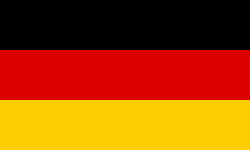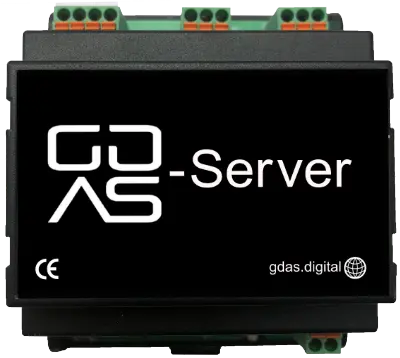Centralised data processing and storage
SQL database integration: : The GDAS server uses an SQL database for the centralised storage of all recorded data. This enables structured management of consumption and production data as well as the storage of historical data in order to carry out long-term analyses.
Datenaggregation: Data streams from different sources can be merged, processed and analysed in real time. This makes it possible to recognise data patterns and define specific rules or alarms.
Data export and API: External systems can access the recorded data via a RESTful API in order to integrate it into third-party systems or export it for further analyses.
Protocol support and gateway functions
The GDAS server supports a variety of bus systems and protocols, which enables flexible integration of a wide range of devices and systems. The most important bus systems and interfaces at a glance:
- KNX: A globally established standard for building automation. KNX enables the control of lighting, blinds, heating and other building technology systems. The GDAS server integrates KNX seamlessly so that control and automation logics can be managed centrally.
- Modbus: A widely used protocol for industrial automation that works via RS-485 and TCP/IP. Modbus is ideal for connecting measuring and control devices such as sensors, counters and PLCs (programmable logic controllers). The GDAS server can act as a Modbus master or slave to exchange data with various devices.
- 1-Wire: A simple and cost-effective bus system that is used in particular for temperature and humidity sensors. The GDAS server can integrate networked sensors via 1-Wire and integrate the recorded data into the central database for monitoring and control.
- MBUS (metre bus): Specially developed for remote meter reading, MBUS is used to transmit consumption data such as water, gas and electricity meters. The GDAS server makes it possible to automatically record and process this data in order to efficiently analyse consumption.
- DMX-Bus: A protocol that is primarily used in lighting control, e.g. for stage lighting and architectural lighting installations. With support for the DMX bus, the GDAS server enables precise control of lighting systems, including complex colour changes and dynamic light shows.
- Network protocols: The GDAS server supports various network protocols such as TCP/IP and UDP for communication via local networks and the Internet. This enables the integration of devices and systems that use IP-based communication, such as cameras, controllers or other IP-based devices.
Interfaces of the GDAS server
The GDAS server offers a variety of integrated interfaces that enable flexible connection and expansion:
- RS 485 / Modbus: This interface allows direct connection to Modbus RTU devices and is ideal for integrating industrial controllers and measuring devices.
- RS 232 / M-Bus: M-Bus devices can be integrated via the RS 232 interface for recording measurement data and controlling meters.
- USB mit 4-Port-Hub: The GDAS server has four USB ports that enable simple connection of external devices, storage solutions or communication modules.
- KNX Bus: The integrated KNX bus allows direct connection to KNX-based building control systems, which enables simple integration of lighting systems, blinds and other KNX devices.
- 1000 Mbit/s LAN interface: The Gigabit LAN interface ensures a fast and reliable network connection and enables the GDAS server to be integrated into existing IT infrastructures and to communicate with cloud services and remote systems.
Internal bus and expansion options
- Internal bus for IO modules: The GDAS server is equipped with an internal bus that enables the connection of various IO modules. These modules can be used for specific requirements such as additional inputs and outputs, analogue signal acquisition or digital controls.
- Scalability up to 495 modules: In total, a single GDAS server can manage up to 495 IO modules, which offers exceptional scalability. This makes it possible to flexibly adapt the server to the requirements of a wide range of projects - from small installations to large, complex applications.
Secure connection to the GDAS portall
The GDAS server establishes a secure connection to the GDAS portal in order to utilise additional functions and extensions. This encrypted connection allows the server to communicate seamlessly with cloud-based applications, opening up new possibilities for integrating AI functions and other IoT devices. This enables the GDAS server to benefit from the portal's advanced data analytics and machine learning algorithms, for example to make predictions about energy consumption, maintenance needs or device failures. At the same time, the connection to the GDAS portal offers centralised management of all connected IoT devices, further increasing the scalability and efficiency of the system.
Additional interfaces and integrations
- Node-RED-Integration: The GDAS server offers direct integration with Node-RED, a browser-based development environment for the visual programming of automation and integration processes. With Node-RED, users can create simple to complex workflows based on the data from the GDAS server using drag-and-drop. This makes it easy to process and combine data from different sources and create customised logic without the need for in-depth programming knowledge.
- Sonos: The GDAS server can be integrated into the Sonos sound system, allowing audio controls to be incorporated into automation scenarios. This makes it possible to control music, alarms or announcements depending on certain events or scenes.
- Philips Hue: With the integration of Philips Hue, the GDAS server supports the control of intelligent lighting systems. Users can use the server to adjust light colours, brightness and light scenes and integrate them into automation systems.
- Shelly: The integration of Shelly devices enables the GDAS server to control intelligent relays and sockets. This offers a flexible way of controlling switching operations of devices via the network and integrating them into existing automation logics.
- ABI alarm systems: The GDAS server supports the integration of ABI alarm systems and enables centralised monitoring and control of the security systems. Alarms and events can be transmitted to the server in real time and automated responses can be set up.
- Jablotron alarm systems: With the integration of Jablotron alarm systems, the GDAS server offers comprehensive monitoring of security functions. This includes the integration of door and window sensors, motion detectors and smoke detectors into the central monitoring and control system.
- Access systems such as Ekey: The GDAS server supports the connection of Ekey fingerprint access systems, which enables simple and secure management of access authorisations. This allows access controls to be integrated into automation scenarios, e.g. to automatically activate lighting and air conditioning when an authorised user enters.
Gateway functionalities: The server acts as a gateway between the various protocols, allowing cross-platform communication and control. For example, KNX-based systems can interact with Modbus or DMX devices, and alarm systems such as Jablotron can be linked to the lighting via Philips Hue. This significantly increases flexibility and functionality in complex installations and makes the GDAS server a central control element in heterogeneous system landscapes.
Integration options for new devices and systems: If there are devices or systems that do not yet communicate natively with the GDAS server, we offer the option of integration if the respective protocol provides an API. This makes it possible to extend the functionality of the GDAS server with user-defined interfaces so that new or specialised devices can also be easily integrated.
Multilingualism and easy customisation
The GDAS server and the associated development studio support multiple languages so that users worldwide can use an interface in their preferred language. The user interface and visualisation can be provided in different languages. If a required language is not yet supported, we offer the option of exporting a language file in CSV format. This CSV file can then be easily translated and then imported back into the GDAS server. After the import, both the development studio and the visualisation (including pop-up messages) are automatically displayed in the new language. This ensures a high degree of flexibility and customisability to meet the needs of international projects.
Visualisation and user interface
GDAS Studio:GDAS Studio provides technicians with an integrated development environment (IDE) that enables graphical and text-based programming. The IDE supports the creation of customised automation logic, scenarios and event controls.
App-based visualisation: Users can conveniently monitor the status of devices, sensors and systems via the mobile app. The app provides clear dashboards that display real-time data, historical trends and alerts, allowing quick analysis and troubleshooting anytime, anywhere.
Mobile support: The app-based visualisation is specially optimised for access via mobile devices such as smartphones and tablets, so that technicians have a complete overview of their systems even when on the move.
Automation and scenario management
The GDAS server supports the creation of complex scenarios and automation rules. This includes the control of lighting systems, shutters, air conditioning and ventilation systems as well as security solutions. Scenarios can be triggered time-controlled, event-controlled or based on sensor values.
Logic programming: With graphical tools and high-level language support, technicians can programme individual logics. This enables, for example, the dynamic adjustment of heating curves based on weather data or the automation of production processes in industry.
Energy and resource management
Solar energy and photovoltaic integration: The GDAS server monitors and controls photovoltaic systems in real time in order to optimise the use of solar power production. Recording the energy generated enables production output to be analysed precisely and consumption strategies to be adapted depending on weather data and energy requirements.
Management of charging stations: The GDAS server supports the intelligent management of electric vehicle charging stations. The charging process can be controlled so that surplus solar power is used directly to charge vehicles. This helps to maximise self-consumption and reduce dependence on grid power.
Optimisation of household consumption: With GDAS, technicians can integrate household appliances and larger consumers, such as heat pumps or air conditioning systems, into the energy optimisation process. By controlling consumers depending on solar power production, the electricity generated in the household is utilised efficiently. For example, energy-intensive appliances can be operated automatically when the solar system is generating a particularly large amount of electricity.
Load management and load shedding: The GDAS server monitors energy consumption throughout the system and can shed loads if necessary to ensure grid stability. The dynamic management of loads and prioritised use of solar power ensures an optimal energy flow.
Real-time energy monitoring: The GDAS server offers comprehensive real-time analysis of energy consumption and production. Technicians can monitor the energy flow between solar generation, household consumption and charging stations, generate detailed reports and thus continuously optimise the efficiency of the systems. This helps to reduce energy costs and maximise self-consumption of the solar power generated.
Security and alarm management
The GDAS server has extensive alarm and notification functions. Sensors and connected devices can detect events such as temperature deviations, water ingress or power failures and trigger immediate notifications via email, SMS or push messages.
Remote monitoring and control: Technicians can access the server via secure connections to monitor systems, adjust configurations and carry out maintenance work. Remote access is secured by encryption and authentication.
Access management: The user administration of the GDAS server allows different access rights to be defined for technicians, administrators and end users in order to control access to critical systems.
Scalability and multi-server operation
The GDAS server is designed for scalability and can be operated in distributed systems with multiple servers. This enables the seamless expansion of the infrastructure and the distribution of the load across multiple servers to ensure high performance and reliability.
Cluster management: With the multi-server functionality, technicians can set up clusters that support load balancing, redundancy and failover strategies. This is particularly important for industrial applications and large building complexes
Integration options and API access
RESTful-API: The API of the GDAS server enables easy access to all recorded data and control functions. External systems can thus read out data, send control commands or customise automation logic.
Cloud connection: The GDAS server can optionally be integrated with cloud services to enable centralised data management and analysis across multiple locations. This makes it easier to manage large networks and analyse data in the cloud.
Conclusion
The GDAS server offers a comprehensive and flexible platform for the automation and control of buildings, water, energy and industrial systems. With broad protocol support, powerful automation and analytics capabilities, and comprehensive security and integration options, the GDAS server is ideal for engineers looking for a reliable and scalable solution. The combination of ease of use and in-depth technical configurability makes the GDAS server the first choice for demanding automation projects.


